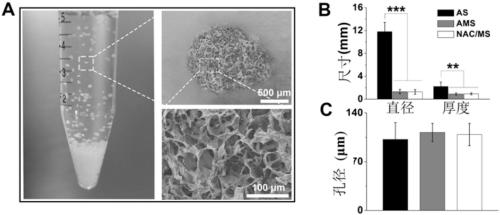Application of nano porous microbracket in tissue regeneration and repair
A nanoporous, tissue regeneration technology, applied in the field of regenerative medicine, can solve the problems of undeveloped stem cell survival, expansion, directed differentiation and injectable three-dimensional porous microscaffolds, etc., achieve small physical size, promote adherence, and facilitate growth the effect of entering
- Summary
- Abstract
- Description
- Claims
- Application Information
AI Technical Summary
Problems solved by technology
Method used
Image
Examples
Embodiment 1
[0124] Example 1 Preparation of nanocarrier-sodium alginate three-dimensional porous micro-scaffold
[0125] 1.1. Synthesis of peptide-laden mesoporous silica nanoparticles (pep@MSNs)
[0126] Mesoporous silica nanoparticles (MSNs) were obtained from Wei Jie's laboratory at East China University of Science and Technology. The specific preparation method is: add 3~9g of Pluronic P-123 (Sigma), 125~130mL of deionized water and 18~25mL of concentrated HCl into a round bottom flask, stir vigorously for 1.5~4h, mix well and place the flask at 50°C In a water bath, add 5-10 g of ethyl orthosilicate while stirring, and stir for 20 hours. Then raise the temperature to 80-85°C, and let it stand at constant temperature for 24-30 hours; then centrifuge (5000-6000G), wash the precipitate with deionized water, dry it and calcinate it in a muffle furnace.
[0127] In this study, the polypeptide we used was a polypeptide derived from the immature region of BMP-7, named BFP-1 (GQGFSYPYKAV...
Embodiment 2
[0139] Example 2 Characterization of nanocarrier-sodium alginate three-dimensional porous micro-scaffold
[0140] Scanning electron microscopy (SEM; S-4800; Hitachi, Japan) was used to characterize the microstructure (pore size, porous morphology, etc.) , USA) was used to determine the elastic modulus of each scaffold.
[0141] Soak the freeze-dried micro-scaffold in PBS, after it fully absorbs water and swells, filter off the PBS, add a little low-concentration sodium alginate solution to the micro-scaffold and mix well, then transfer to a syringe (1mL size) for freeze-drying . For in vivo experiments, just add the cell suspension to the micro-scaffold and mix well before injection. Injectability was verified with dense tissue.
[0142] The sustained-release properties of BFP-1 coated in NAC / MS were characterized by measuring the sustained-release profile of BFP-1 over time. Briefly, the BFP-1 used in the preparation of NAC / MS for the determination of sustained-release ...
Embodiment 3
[0150] Embodiment 3 injectable NAC / MS preparation
[0151] Soak the prepared NAC / MS in PBS at 4°C for 48h; then filter off the PBS, transfer the NAC / MS to a 1ml syringe, plug the injection plunger, freeze-dry and store in a sealed container at 4°C.
PUM
| Property | Measurement | Unit |
|---|---|---|
| diameter | aaaaa | aaaaa |
| pore size | aaaaa | aaaaa |
Abstract
Description
Claims
Application Information
 Login to View More
Login to View More - R&D
- Intellectual Property
- Life Sciences
- Materials
- Tech Scout
- Unparalleled Data Quality
- Higher Quality Content
- 60% Fewer Hallucinations
Browse by: Latest US Patents, China's latest patents, Technical Efficacy Thesaurus, Application Domain, Technology Topic, Popular Technical Reports.
© 2025 PatSnap. All rights reserved.Legal|Privacy policy|Modern Slavery Act Transparency Statement|Sitemap|About US| Contact US: help@patsnap.com



